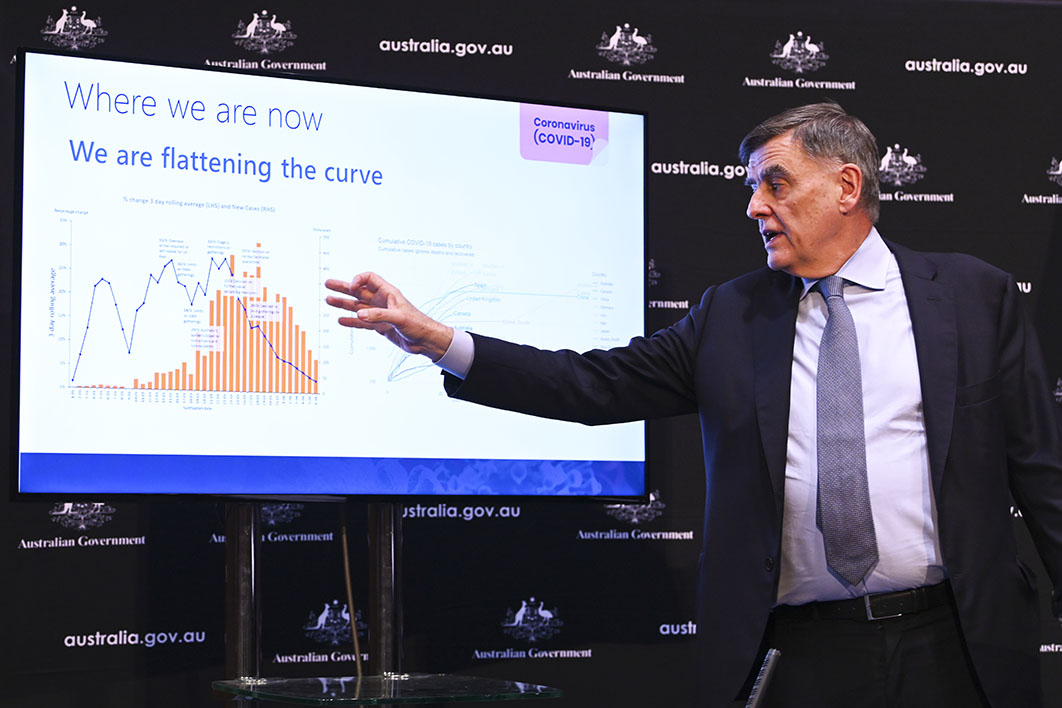This week has seen tentative signs that Australia’s response to Covid-19 might be “bending the curve” — in other words, slowing the rate of increase in the cumulative number of cases. The figures have set off a struggle among commentators to define the significance of this moment.
Libertarian think tanks and law and economics professors expressed concern that the cure might have been worse than the illness. (This, of course, is a position you can only hold if the cure actually works.)
From all quarters came calls for caution against complacency. Some commentators who had courted panic by interpreting the initial slope of the curve as evidence of exponential local transmission now scrambled to point out that the slowing reflects the drop-off in overseas visitors, with local transmissions continuing their trend of gradual increase. Advocates of an elimination strategy argued that now is the time for lockdown, scenting the prospect of completely eradicating local transmission.
As the pace of new diagnoses begins to slow, at least for the moment, it seems a good time to reflect on the mid-to-long term. What would an endgame look like?
We have had an intense debate over what broad approach we are taking — flattening or bending the curve, or complete eradication. In practice, the methods are the same; the difference is a matter of timing and emphasis. But debate still rages over a false dichotomy expressed in loaded terms: after all, who wants to advocate a policy widely described as mitigation?
Yet “flattening” includes preventing cases, not just spacing them out so that hospitals can cope, while “eradication” anticipates that the epidemic would rebound if restrictions were eased too early or lifted altogether.
Nobody at the centre of Australia’s response to the epidemic believes we are going to see results from a “short, sharp shutdown,” as advocated by some vocal commentators. At state and federal levels, chief health and medical advisers say restrictions must remain in place for months and may intensify.
In the discipline of change management, there’s a saying, attributed to Peter Drucker, that “culture eats strategy for breakfast.” Simple and decisive strategies like lockdown can easily founder on the shoals of implementation. The PM has fairly been criticised for making a hash of communicating the government’s piecemeal introduction of recommendations and restrictions. But that graduated introduction, with heavy foreshadowing of tighter restrictions to come, has given the public time to prepare, mentally and practically, for a curtailment of everyday life that is likely to be a marathon rather than a sprint.
The big question is what happens when restrictions are lifted: does the epidemic rebound? This is where notions of flattening or bending the curve fall short. The most well-known alternative is a model developed by Neil Ferguson and popularised by startup founder Tomas Pueyo that explicitly anticipates rebound. Pueyo called its two moves “the hammer” — an initial, immediate, short, sharp lockdown — and “the dance” — monitoring the epidemic and pulsing restrictions on and off, as needed, to curb the epidemic’s growth.
What this fantasy born of simulation overlooks is that policy involves people. Trying to plan ahead without any certainty about whether and when restrictions will be reimposed will become extremely burdensome. As the public tires of the dance, adherence will decrease, and it will lose effectiveness. Of course, this problem applies equally to all restrictions.
It all comes down to rebound. If Australia succeeds in bending the curve, does the rate of new infections simply return to unacceptable levels when restrictions are lifted?
We can easily imagine rebound happening if travel bans are lifted while the pandemic rages unchecked beyond our borders. Within our borders, though, Australia relies on precarious migrant labour — people whose lack of social security means they have to work in order to survive, even if they have mild respiratory symptoms. Low-level ongoing transmission among workers exempted from stay-home measures, be they permanent residents or otherwise, could allow rebound even without any easing of overseas travel bans.
We are watching carefully for rebound in countries that have controlled their initial outbreaks using the same approach as our own — intensive social distancing, aggressive contact tracing, and isolation of known and suspected cases. Both China and Singapore, exemplars of this approach, have reported mild increases in cases involving local transmission. Singapore this week opted to introduce more intensive social distancing measures involving shutdowns.
Epidemics are complex and unpredictable, and a cluster or super-spreader event could change the behaviour of our outbreak altogether.
We don’t know if or when a vaccine will become available. Until that happens, we are facing prolonged restrictions and ongoing uncertainty about the endgame. Our approach needs to respond to our own epidemic, our own population and our own health service capacities. It will not slot neatly into some conceptual debate, nor should we expect it ever would. •
BONUS READING
This article includes some text from a new resource by the author outlining the evidence and experience underlying Australia’s recommendations for preventing transmission and curbing the outbreak. It’s available free here.




